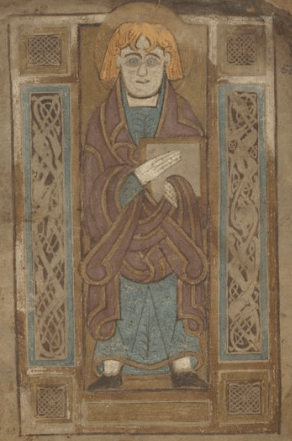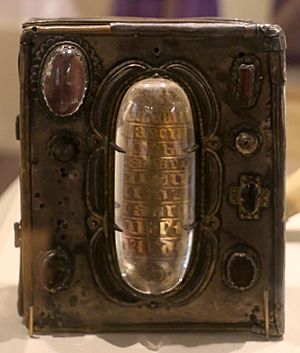Book of Mulling facts for kids

The Book of Mulling is an old Irish Gospel Book. It was made around the late 700s or early 800s. You can find it today at Trinity College Library in Dublin, Ireland. This book is special because it's a "pocket" Gospel Book, meaning it was small enough to carry around.
It contains the four Gospels (stories about Jesus's life), a church service, and a special note at the end. This note supposedly shows a map of St. Moling's monastery.
People used to think that St. Moling himself wrote the book. His name is even in a note at the end of St. John's Gospel. However, experts now know the book was made after St. Moling died in 697. Also, three different scribes (people who copied books by hand) worked on it! One wrote the introductions, another wrote the Gospels of Matthew, Mark, and Luke, and a third wrote St. John's Gospel. It's still possible that they copied it from an earlier book written by St. Moling.
The writing style is called Irish minuscule. This book is one of the last examples of a very fancy style used in illuminated manuscripts. These are books with beautiful pictures and designs. The Book of Mulling has decorated letters and three surviving pictures of the Gospel writers: Matthew, Mark, and John. The special box that held the book, called a cumdach, is also kept at Trinity College.
Exploring the Portrait of John
The picture of John the Evangelist in the Book of Mulling is very detailed. John is shown facing straight forward. He holds a book or tablet close to his chest, which might show he was a writer of one of the Gospels.
John has blond hair and blue eyes. His clothes are rich blue and red. The robes seem to flow around him, forming cool, almost geometric shapes. These shapes are similar to the designs around the edge of the picture.
There's a border around the portrait. John's halo, which shows he is holy, actually breaks through this border. The top and bottom parts of the border are simple. But on the left and right sides, there are very fancy designs.
Artistic Details in the Portrait
The corners of the picture are filled with interlaced line-work. This means lines are woven together in a complex pattern. Two panels on the left and right have interlocking animal shapes. These animals are stretched out and woven together so much that they are hard to recognize! Both these patterns look like the metalwork art that was popular back then.
The colors in the portrait have faded over time. But you can still see how rich and detailed this image is. The artists even used gold! This makes it one of the best examples of illuminated manuscript art from that time.
The Early Irish Manuscripts Project
Trinity College, Dublin has started a big project called the Early Irish Manuscripts Project. Their goal is to protect, study, and make digital copies of their old books. These books include the Book of Mulling, the Book of Dimma, the Garland of Howth, and the Codex Usserianus Primus.
This project has helped new research happen on these old books. It also means more people can see them, as they are available online. The project uses special methods, like non-destructive pigment analysis, to study the colors without harming the books.


